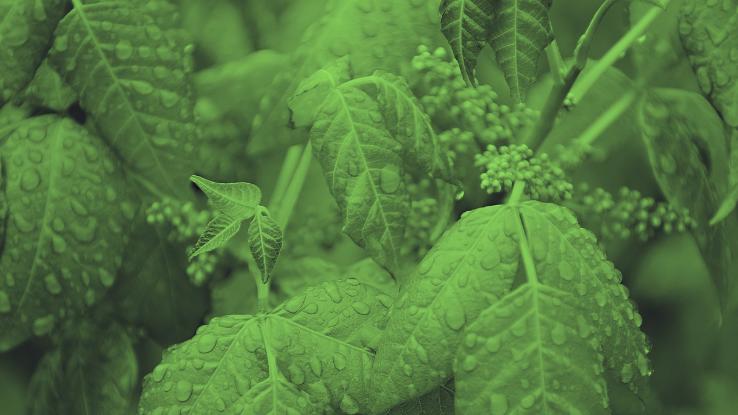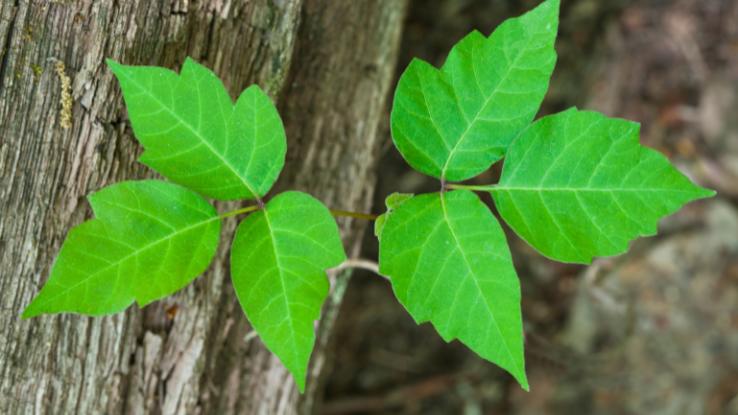Why Did They Recast Poison Ivy Again]

When it comes to summer traditions and rites of passage, you might call back of watching baseball, catching fireflies and lazing on the beach. Many of us jump to outdoor activities, like camping ground or hiking. The but problem? Some of these quintessential summer activities come with a few potential downsides, including sunburns and running into poisonous substance ivy.
Co-ordinate to the American Skin Association, toxicant ivy reactions are the about common allergic reaction in the United States — one that affects 50,000,000 Americans annually. Not sure how to deal with the plant or its infamous rash? Here's everything you need to know when it comes to encountering poison ivy this summer.
Toxicant ivy is a constitute institute on every continent and in every American state except Hawai'i and Alaska. You're virtually likely to find poison ivy and its relatives-of-sorts, poison oak and toxicant sumac, in wooded and marshy areas. Odd as it might seem, the plants themselves aren't really poisonous, only they all contain a sticky oil called urushiol — and it's this urushiol that'south the culprit when it comes to that infamous itchy, baking peel rash. Information technology doesn't have much oil to cause a several rash; just brushing up against the found can transfer urushiol from the plant to your skin.

One key to recognizing and identifying poison ivy is to remember the phrase "leaves of three, let it be." Toxicant ivy always has 3 pointy, polish-surfaced leaves. Ane foliage is clearly centered and points upwards while the other two leaves tend to point off to the sides. The leaves of a poisonous substance ivy constitute are shiny and take smooth or slightly notched edges. The stems of a toxicant ivy plant are reddish and have no thorns.
Like poison ivy, poison oak grows as a shrub or a vine. While poisonous substance oak is similar in appearance to poison ivy, information technology has larger and more than rounded leaves — not totally dissimilar the leaves of an oak tree — with a hairy, textured surface. The leaves of poison oak come in groups of 3, five or seven. Finally, poison sumac is a shrub or tree with leaves that come in clusters of seven to 13 leaves arranged in pairs on either side of a single stem, with a unmarried leaf standing alone on the very stop of the stem.
How to Become Rid of Poison Ivy Plants
1. Dig the Plants Out of Your G
The near effective way to eliminate poison ivy from your property is to physically remove the plants themselves from your country. While wearing long sleeves, gloves, long pants and closed-toed shoes, pull or dig the entire plant out of the footing. Keep in mind that poison ivy can appear as an ivy, meaning information technology may enter the footing far from where y'all notice the leaves.
Advisedly trace the stems dorsum to the roots, gather upward all leaves and stems, and dig out all roots thoroughly. Don't just snap off the roots; they'll produce new plants. Once you're washed, bag all the material and throw information technology all away. Don't compost it or burn it — after all, you don't desire to encounter the oils again later.

ii. Utilize Chemic Herbicides
More and more people are reluctant to use chemical herbicides in their yards and gardens and on their property due to environmental concerns. When it comes to managing poison ivy, though, consider making an exception. While using chemical herbicides is not the most environmentally friendly option for dealing with toxicant ivy, commercial herbicides are highly effective — especially if you lot're dealing with poison ivy over a big surface area. Chemical herbicides containing glyphosate are particularly effective against poison ivy because these poisons attain poison ivy's complex organization of roots.
Clemson University'due south College of Agriculture, Forestry and Life Sciences provides a very useful discussion of chemical herbicides to help determine which is best to kill poison ivy. Clemson's listing of products includes:
- Ortho GroundClear Poison Ivy & Tough Brush Killer
- BioAdvanced Brush Killer Plus Ready-Acme-Use
- Roundup Ready-to-Use Poison Ivy Plus Tough Brush Killer
- Super Concentrate Killzall Weed & Grass Killer
- Zep Enforcer Weed Defeat
When using any chemical product, be sure to follow all provided instructions to the letter.
3. Make (and Apply) Bootleg Poison Ivy Killer
If you'd prefer to use a DIY poison ivy killer, attempt the following combination: Dissolve one cup of salt in a combination of 1 tablespoon of white vinegar, one tablespoon of dish soap and i gallon of water. Pour the mixture — it'll be soapy, so don't be surprised — into a make clean spray bottle from a hardware store and soak the entire toxicant ivy plant with the potion. Better nonetheless, do this, and and then, in one case the plant is expressionless, follow the higher up instructions for digging it out safely.
What Can You Exercise About a Poison Ivy Rash?
If y'all get urushiol on your pare — whether from poison ivy, poison sumac or poisonous substance oak — y'all'll develop three types of symptoms within minutes, hours or days. The unholy trinity of poison ivy exposure symptoms is itchiness, followed by a red rash and then blisters. When it comes to the best treatments for poison ivy, you have bootleg and store-bought options. Store-bought remedies for a toxicant ivy-related rash include topical calamine lotions, hydrocortisone creams and oral antihistamines.

If you'd prefer a dwelling remedy for dealing with your poison ivy rash, try apple tree cider vinegar in i of the following ways1:
- Apply apple cider vinegar every bit an astringent past soaking a cotton ball in a teaspoon of apple cider vinegar. (You can also use a one-half-and-one-half mix of h2o and apple tree cider vinegar.) Press the vinegar-soaked cotton brawl against your rash three to 4 times daily. This has been touted equally helpful for itchiness, simply don't effort information technology if blisters take adult.
- Try a wet vinegar compress to soothe itching and swelling. To brand a compress, combine equal amounts of absurd water and apple tree cider vinegar in a clean basin or jar. Soak a clean cloth or rag in that combination, and then lay that vinegar-soaked fabric on your rash for fifteen minutes to half an hour. Repeat the process a few times a day, but be sure to use a clean rag every time that you do.
- Make a vinegar spray if you'd rather not utilize cotton balls or rags (or don't have whatsoever on hand). Only combine equal amounts of apple tree cider vinegar and h2o and cascade the mix into a clean spray bottle. Don't use a spray bottle that was used for cleaning products. Utilize a clean one. Just spray the mixture onto your rash several times daily.
- Many people tout the merits of witch hazel, a paste of baking soda (iii parts) and water (1 part), aloe vera gels, chamomile and eucalyptus essential oils, and even cucumber slices to provide relief from the itchiness and swelling associated with poison ivy-related rashes, too.
1 Editor's Annotation: Exist sure to first wash your skin with soap and absurd or lukewarm (that is, non hot) h2o immediately after being exposed to urushiol.
Resource Links:
- "Poison Ivy, Sumac and Oak" via American Skin Association
- "Toxicant Ivy Rash" via Mayo Clinic
- "Summer Skin Rashes" (slideshow) via Mayo Clinic
- "Poisonous substance Ivy, Oak, and Sumac: Who Gets a Rash, and Is It Contagious?" via American Academy of Dermatology Association
- "Outsmarting Poison Ivy and Other Poisonous Plants" via U.S. Nutrient & Drug Administration (FDA)
- "Poison Ivy" via Home & Garden Information Middle | Clemson University: Higher of Agriculture, Forestry and Life Sciences
- "How to Impale Toxicant Ivy" via HGTV
- "6 Tips For Removing Poison Ivy" via Farmers' Annual
Source: https://www.symptomfind.com/health/homemade-poison-ivy-killer-and-rash-remedies?utm_content=params%3Ao%3D740013%26ad%3DdirN%26qo%3DserpIndex
Post a Comment for "Why Did They Recast Poison Ivy Again]"